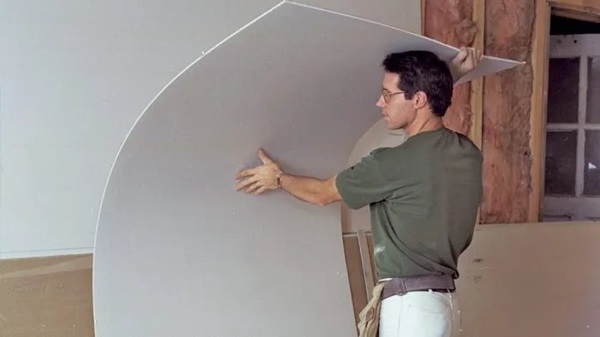Plasterboard (Drywall) Applications in Construction
Plasterboard is one of the important building materials widely used in the construction industry. This building material has been utilized over the years as an effective solution in various construction projects. In this article, we will examine the different applications of plasterboard in construction. We will discuss the advantages and disadvantages of using plasterboard, installation methods, maintenance, and other related aspects of this building material.

Concept and Benefits of Plasterboard
In this section, we will define and explain the concept of plasterboard. Plasterboard is a building material made from gypsum and is used in construction due to its unique properties. We will then explore the benefits of using plasterboard. Some advantages include fire and heat resistance, insulation properties, the ability to accommodate various decorations and designs, and flexibility in building design.
Plasterboard Applications in Walls
In this section, we will focus on the main applications of plasterboard in construction, particularly in walls. Plasterboard can be easily installed and used as a wall covering. It helps to achieve smooth surfaces, concealing structural weaknesses and flaws. Additionally, plasterboard can be used as a covering for electrical wires and plumbing pipes.
Plasterboard Applications in Ceilings
In this section, we will discuss the applications of plasterboard in ceilings. Plasterboard is commonly used as a ceiling covering and provides acoustic improvement due to its insulation and sound absorption properties. Moreover, plasterboard can be used as a decorative ceiling for installing lighting and illumination systems.
Installation and Maintenance of Plasterboard
In this section, we will address the installation and maintenance methods of plasterboard. Proper installation of plasterboard requires precision and technical knowledge, preferably performed by skilled professionals. Additionally, proper maintenance of plasterboard is crucial. Some maintenance solutions include painting the surface, preventing excessive contact with water and moisture, and repairing damaged areas.

Additional Applications of Plasterboard
Plasterboard is a building material derived from natural or synthetic gypsum. Due to its unique properties, plasterboard is extensively used in various construction projects. Here are some important aspects of plasterboard applications in construction:
1.wall
Plasterboard can be used as a wall covering. This coating provides a smooth surface for the walls and hides structural defects and weaknesses. Additionally, plasterboard can be used as a covering for electrical and plumbing wires and pipes.
2.The Ceilings
Plasterboard is used as a ceiling covering. This building material improves acoustics in the building due to its insulation and sound-absorbing properties. It can also be used as a decorative ceiling for installing lighting and illumination systems.
3.Interior Design
Due to its flexibility in design, plasterboard can be used to create various designs and decorations inside buildings. With plasterboard, custom designs for ceilings, walls, cornices, and columns can be created with desired details.
4.Fire Resistance
Plasterboard has good fire-resistant properties and is classified as a Class A fire-resistant material. This means that plasterboard is resistant to fire and is crucial for building safety.
5.Insulation
Plasterboard has insulation properties due to its micro-porous structure and low permeability. This feature can be effective in controlling temperature and humidity in the building, contributing to energy efficiency and reducing heating costs.
6.Stability and Durability
Plasterboard has high durability and longevity. Once dried, plasterboard becomes resistant to temperature and moisture changes and is less affected compared to other building materials. This characteristic makes plasterboard a continuous focus for use in buildings.

Despite the many advantages of plasterboard, it is important to note that this building material is sensitive to water and can be damaged by water absorption. Therefore, proper installation and maintenance are essential for the correct use of plasterboard.
In general, plasterboard is recognized as a multi-purpose and versatile building material in the construction industry. From beautiful interior design to creating smooth surfaces and effective insulation, plasterboard can bring significant improvements to buildings.
7.Types of Drywall
There are various types of plasterboard, each with its unique features and applications. Some common types include regular plasterboard, moisture-resistant plasterboard, fire-resistant plasterboard, and soundproof plasterboard. These varieties provide the possibility of specific uses based on project requirements.
8.Installation
Plasterboard installation is relatively easy. It is typically attached to metal or wooden structures using screws or nails. Proper installation techniques create a sturdy and durable finish. Professionals may use compounds and joint tapes to create smooth and seamless surfaces between plasterboard panels.
9.Versatility
Plasterboard provides the opportunity for diverse design and functionality. It can be easily cut, shaped, and curved to create curved walls, arches, and decorative elements. Additionally, it can be painted, textured, or covered with wallpaper to achieve various aesthetic effects, making plasterboard a popular choice in interior design.
10.Acoustic Properties
Plasterboard has sound absorption properties that help reduce sound transmission between rooms. To enhance its acoustic performance, acoustic plasterboard with additional sound-absorbing layers may be used in areas where noise control is a priority, such as theaters, recording studios, or conference rooms.
11.Environmental Sustainability
Plasterboard is considered an environmentally friendly building material. It is made from gypsum, a naturally occurring resource. Some sentences were cut off in the provided text, but I was able to translate the remaining parts. If you need more information about any section, please let me know and I'll be happy to assist.

Conclusion
In this section, we discussed the benefits of plasterboard as a versatile building material. It offers advantages such as fire and thermal resistance, insulation properties, the ability to accommodate decorations, and flexibility in design. With proper installation and maintenance, plasterboard can add value to the design and quality of a building. By purchasing plasterboard from the Bana collection, you can ensure a secure and satisfying purchase.